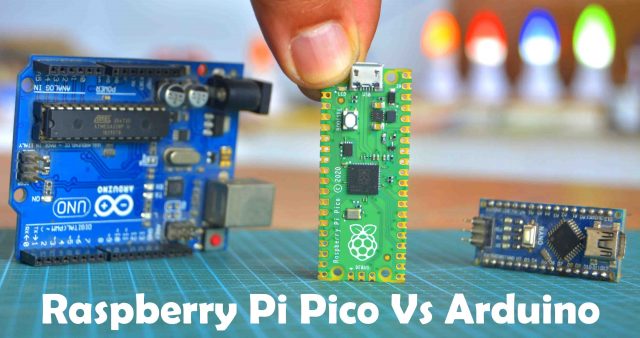Raspberry Pi Pico Vs Arduino
Table of Contents
Raspberry Pi Pico RP2040 Vs Arduino:
Raspberry Pi Pico RP2040 Vs Arduino- As beginners, we often get confused while deciding which controller board is best for a particular project. How to know when to use an Arduino board and when to use the Raspberry Pi Pico? In this article, we will do a side by side comparison of the Raspberry Pi Pico with the Arduino and then you can decide which controller board you need for your project. So, without any further delay, let’s get started!!!
Amazon Links:
Other Tools and Components:
Super Starter kit for Beginners
PCB small portable drill machines
*Please Note: These are affiliate links. I may make a commission if you buy the components through these links. I would appreciate your support in this way!
Raspberry Pi Pico Vs Arduino:
I am going to do a side by side comparison of the Raspberry Pi Pico and Arduino as this is the only way to let you know; how powerful is Raspberry Pi Pico.
| Arduino | Raspberry pi Pico | |
| Microcontroller | Atmega328p single core | RP2040 dual-core |
| Core Architecture | 8-bit RISC | 32-bit ARM cortex-MO+ |
| CPU Clock | 16MHz | 48MHz , up to 133MHz |
| RAM Size | 2 Kbyte | 264kbyte(SRAM) |
| Flash Size | 32 Kbyte | 2Mbyte(Q-SPI Flash) |
| EEPROM | 1 Kbyte | None |
| Programming | C alike Arduino IDE | Micro python, c, and c++ |
| Board power input | 5VDC via USB B | 5 VDC via USB micro B |
| Alternative Board power | 7-12 VDC via DC Socket | 1.8-5VDC via VSYS pin(pin 39) |
| MCU | 5 VDC | 3.3 VDC |
| USB interface | External USB serial IC | USB 1.1 Device and host |
| Program loading | USB B, virtual serial port | USB micro B, USB mass Storage |
| Gpio digital I/O | 20 | 26 |
| ADC | 6 x 10bit | 3 x 12 bit |
| UART | 1 | 2 |
| I2C | 1 | 2 |
| SPI | 1 | 2 |
| PWM | 6 | 16 |
| On-board led | 1 connected with D13 | 1 connected with GP25 |
| Price | USD | USD |
Arduino is based on the Atmega328 single-core microcontroller while the Raspberry Pi Pico is based on the RP2040 Dual-Core.
Arduino has 8-bit Core Architecture while the Pico has 32-bit ARM Cortex M0+.
Arduino has a 16MHz CPU Clock while the Pico has up to 133MHz.
RAM size on Arduino is 2 Kbyte and on Pico, it’s 264Kbyte.
Flash size on Arduino is 32 Kbyte and on Pico it’s 2Mbyte.
EEPROM in Arduino is 1 Kbyte while in Pico there is no EEPROM.
Arduino programming is done in C using Arduino IDE while the Raspberry Pi Pico programming is done in Micro Python, C, and C++, and I will use Thonny IDE.
In Arduino, the Board Power Input is 5Vdc which is given through USB B while in Raspberry Pi Pico the 5Vdc is supplied via USB micro B.
Alternative Board Power in Arduino is 7 to 12 volts DC which is given via DC female Socket while in Pico board the voltage range is from 1.8 to 5 volts DC which is supplied via VSYS pin 39.
Arduino is based on the 5Vdc compatible microcontroller unit while the Pico board is based on the 3.3V compatible microcontroller unit.
USB interface in Arduino is an External USB serial IC and in Pico board its USB 1.1 Device and host.
Arduino uses USB B, a virtual serial port for the program loading while the Pico board uses USB micro B, USB mass storage.
Arduino has 20 digital pins while Raspberry Pi Pico has 26 digital pins.
In Arduino, ADC is 6x10bit while in Pico its 3x12bit.
Arduino has 1 UART and Pico has 2.
Arduino has 1 I2C and Pico has 2.
Arduino has 1 SPI and Pico has 2.
Arduino has 6 PWM pins and the Pico board has a total of 16 PWM pins.
The onboard LED in Arduino is connected to pin13 while in Raspberry Pi Pico the onboard led is connected to GP25.
The Arduino board price may vary depending on whether you are purchasing the clone version or the Genuine, But even the clone version is more expensive than the Raspberry Pi Pico. On most online stores the Raspberry Pi Pico board is only 4 dollars. After this detailed comparison, I must say Raspberry Pi Pico is the future. Anyway, let’s move on to the next step which is now I am going to explain the Raspberry Pi Pico Pinout in very detail.
Watch Video:





